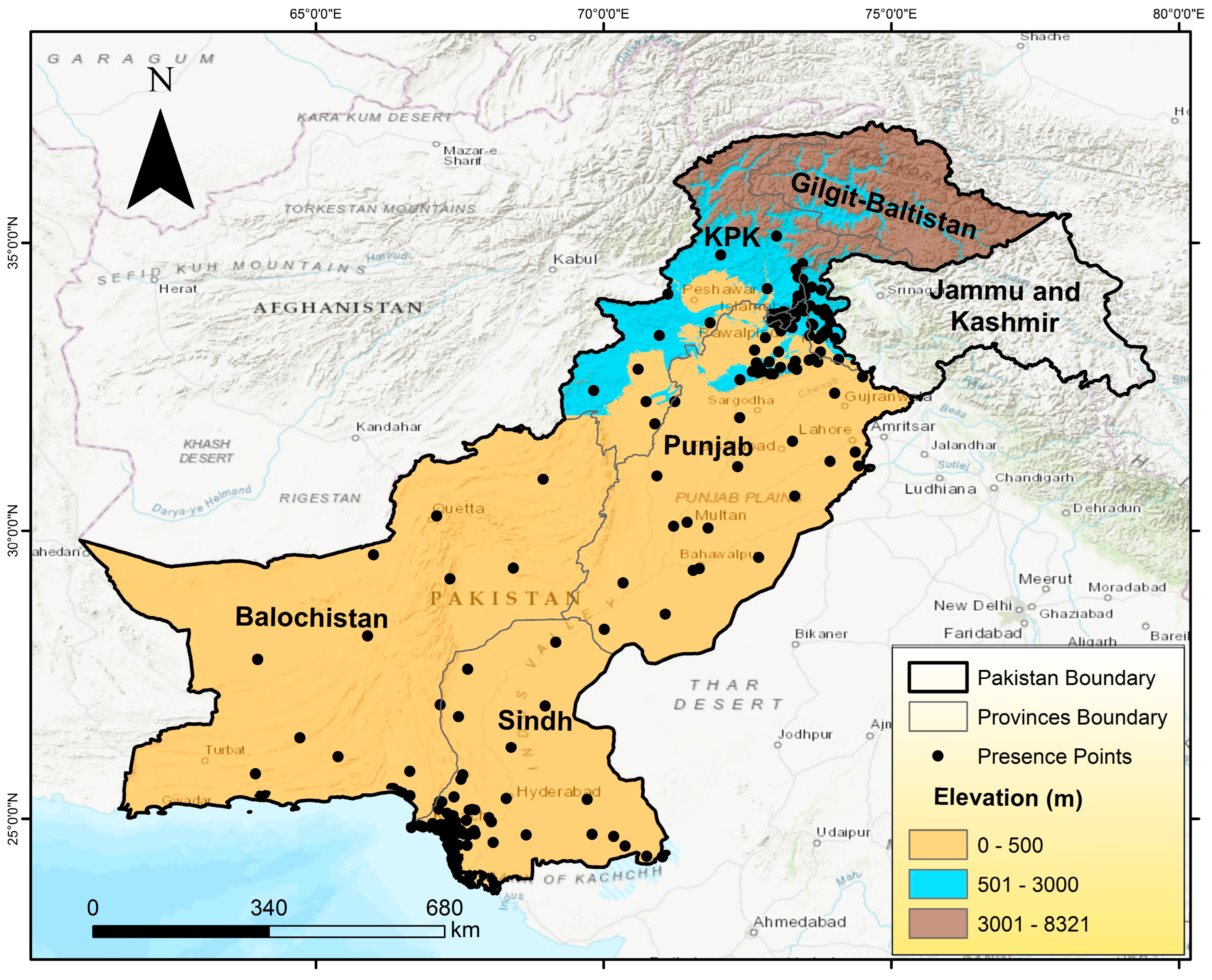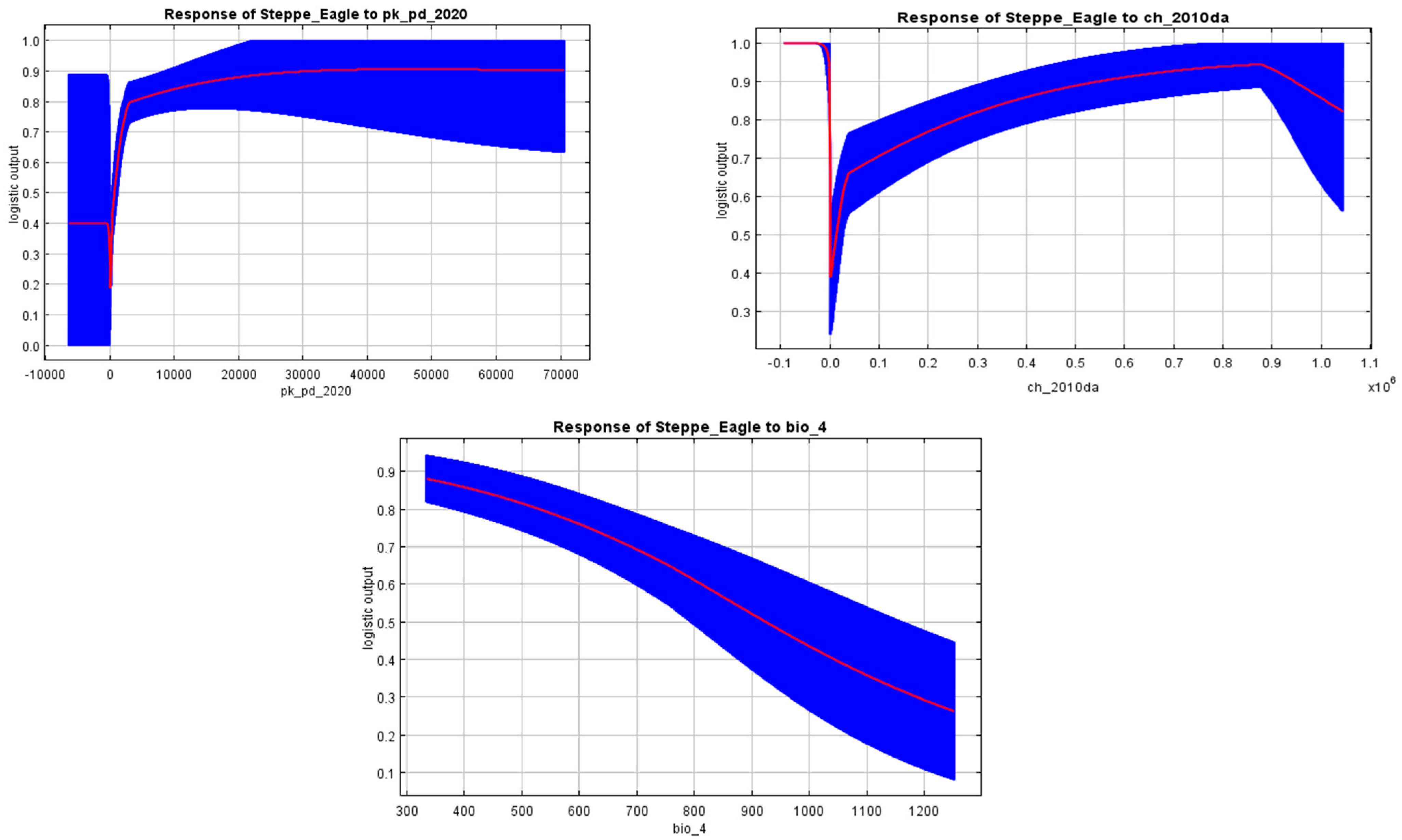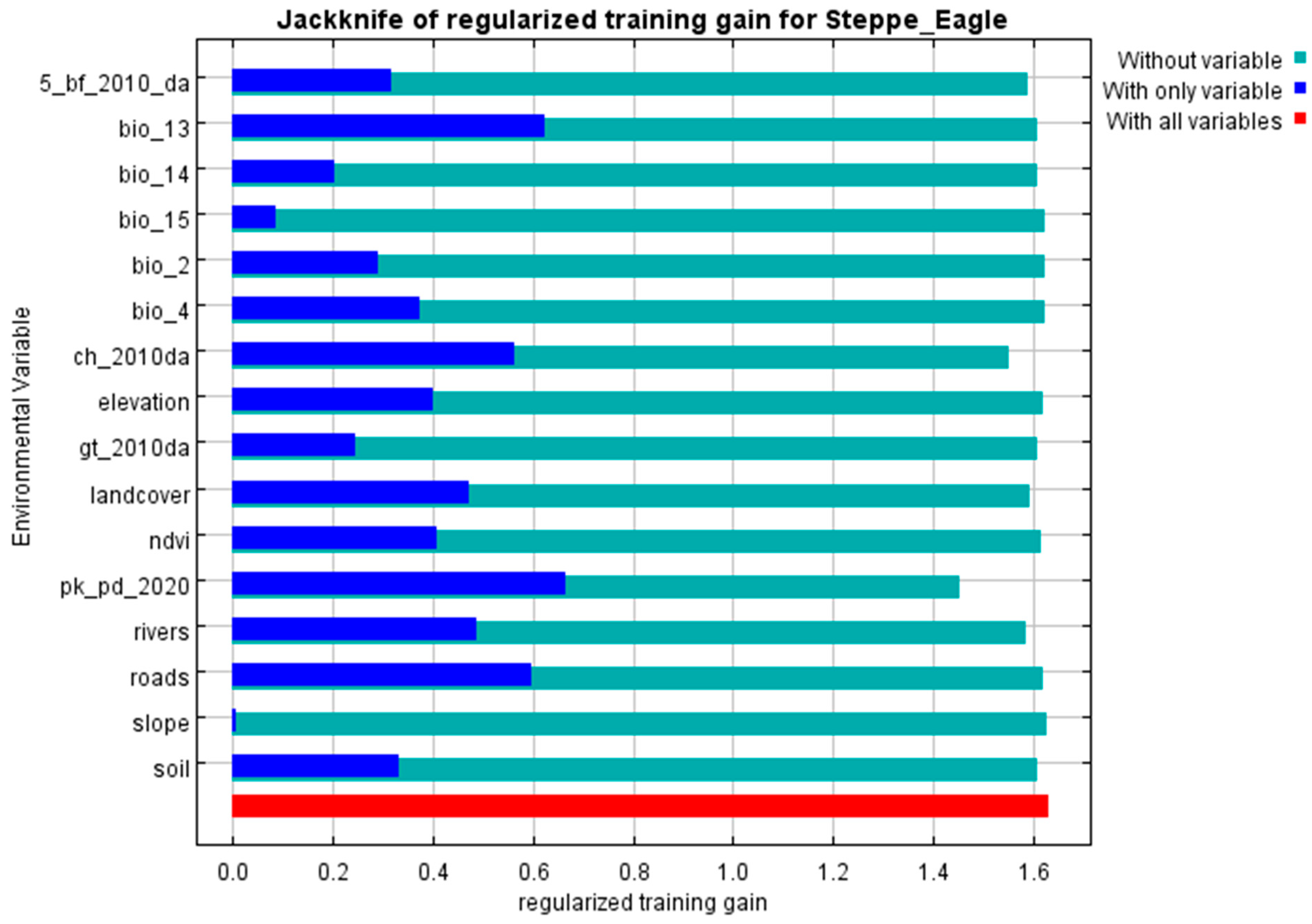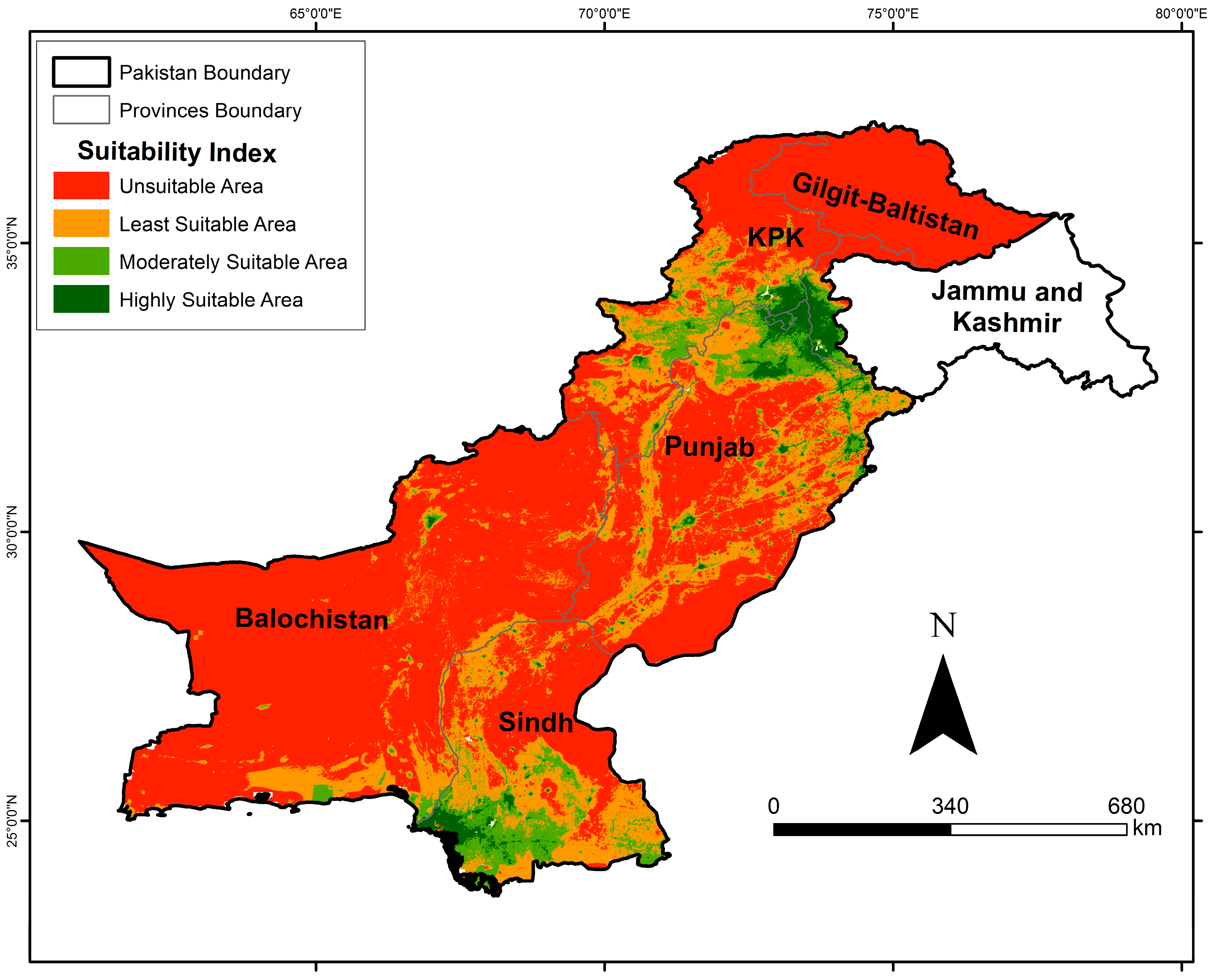Factors Affecting Habitat Selection of Endangered Steppe Eagle (Aquila nipalensis) in Pakistan: Implications for Raptors Conservation
Abstract
1. Introduction
2. Materials and Methods
2.1. Study Area and Species Presence Data
2.2. Environmental Data
2.3. Data Analysis
2.3.1. Selection of Presence Data and Environmental Variables
2.3.2. Model Simulation and Evaluation
3. Results
3.1. MaxEnt Prediction Evaluation
3.2. Influential Factors Determining Habitat Suitability
3.3. Distribution of Suitable Steppe Eagle Habitat
3.4. Suitable Area
4. Discussion
Model Constraints
5. Conclusions
Supplementary Materials
Author Contributions
Funding
Data Availability Statement
Acknowledgments
Conflicts of Interest
References
- Donázar, J.A.; Cortés-Avizanda, A.; Fargallo, J.A.; Margalida, A.; Moleón, M.; Morales-Reyes, Z.; Moreno-Opo, R.; Pérez-García, J.M.; Sánchez-Zapata, J.A.; Zuberogoitia, I.; et al. Roles of Raptors in a Changing World: From Flagships to Providers of Key Ecosystem Services. Ardeola 2016, 63, 181–234. [Google Scholar] [CrossRef]
- Bonebrake, T.C.; Christensen, J.; Boggs, C.L.; Ehrlich, P.R. Population Decline Assessment, Historical Baselines, and Conservation. Conserv. Lett. 2010, 3, 371–378. [Google Scholar] [CrossRef]
- Le Viol, I.; Jiguet, F.; Brotons, L.; Herrando, S.; Lindström, Å.; Pearce-Higgins, J.W.; Reif, J.; Van Turnhout, C.; Devictor, V. More and More Generalists: Two Decades of Changes in the European Avifauna. Biol. Lett. 2012, 8, 780–782. [Google Scholar] [CrossRef] [PubMed]
- Barnosky, A.D.; Matzke, N.; Tomiya, S.; Wogan, G.O.U.; Swartz, B.; Quental, T.B.; Marshall, C.; McGuire, J.L.; Lindsey, E.L.; Maguire, K.C.; et al. Has the Earth’s Sixth Mass Extinction Already Arrived? Nature 2011, 471. [Google Scholar] [CrossRef] [PubMed]
- Dirzo, R.; Young, H.S.; Galetti, M.; Ceballos, G.; Isaac, N.J.B.; Collen, B. Defaunation in the Anthropocene. Science 2014, 345, 401–406. [Google Scholar] [CrossRef]
- Umar, M.; Hussain, M.; Murtaza, G.; Shaheen, F.A.; Zafar, F. Ecological Concerns of Migratory Birds in Pakistan: A Review. Punjab Univ. J. Zool. 2018, 33, 69–76. [Google Scholar] [CrossRef]
- Khattak, R.H.; Teng, L.; Ahmad, S.; Bari, F.; Rehman, E.U.; Shah, A.A.; Liu, Z. In Pursuit of New Spaces for Threatened Mammals: Assessing Habitat Suitability for Kashmir Markhor (Capra Falconeri Cashmeriensis) in the Hindukush Range. Sustainability 2022, 14, 1544. [Google Scholar] [CrossRef]
- Johnson, D.H. The Comparison of Usage and Availability Measurements for Evaluating Resource Preference. Ecology 1980, 61, 65–71. [Google Scholar] [CrossRef]
- Yun-sheng, W.; Bing-yanl, X.; Fang-hao, W.; Qi-ming, X.; Liang-ying, D. ScienceDirect The Potential Geographic Distribution of Radopholus Similis in China. Agric. Sci. China 2007, 6, 1444–1449. [Google Scholar]
- Yackulic, C.B.; Chandler, R.; Zipkin, E.F.; Royle, J.A.; Nichols, J.D.; Campbell Grant, E.H.; Veran, S. Presence-Only Modelling Using MAXENT: When Can We Trust the Inferences? Methods Ecol. Evol. 2013, 4, 236–243. [Google Scholar] [CrossRef]
- Khan, M.S. Amphibians and Reptiles of Pakistan.; Krieger Publishing Company: Malabar, FL, USA, 2006. [Google Scholar]
- Ahmad, S.; Bari, F.; Kabir, M.; Baig, M.A.; Khan, T.; Khattak, R.H.; Rehman, E.U. Population Status and Roost Site Selection of Endangered Egyptian Vultures (Neophron Percnopterus) in Poonch River Mahasheer National Park, Azad Jammu and Kashmir, Pakistan. J. Raptor Res. 2021, 55, 99–105. [Google Scholar] [CrossRef]
- Bari, F.; Rehman, E.U.; Kabir, M.; Ahmad, S. An Extension to the Known Wintering Range of the Steppe Eagle Aquila Nipalensis, in the Poonch and Jhelum Valleys, Azad Jammu and Kashmir, Pakistan. Ardeola 2020, 67, 415–422. [Google Scholar] [CrossRef]
- Ahmad, S.; Rehman, E.U.; Kabir, M.; Bari, F. Population Status and Nesting Activity of White-Rumped Vulture Gyps Bengalensis in Kotli District, Azad Jammu and Kashmir, Pakistan. Ornithol. Sci. 2020, 19, 55–61. [Google Scholar] [CrossRef]
- Khattak, R.H.; Xin, N.J.; Xin, Z.; Xin, Z.; Ahmad, S.; Rehman, E.U. An Avi-Faunal Inventory of Miangan Tarakai Game Reserve: A Future Destination for Eco-Tourists. Pakistan J. Life Soc. Sci. 2020, 17, 39–45. [Google Scholar]
- Bildstein, K.L. Migrating Raptors of the World: Their Ecology and Conservation; Cornell University Press: Ithaca, NY, USA, 2006. [Google Scholar]
- Sheikh, K.M.; Kashif, N. Strategic Role of Pakistan Wetland Resources: Prospects for an Effective Migratory Waterbird Conservation Network. In Waterbirds Around the World; The Stationery Office: Edinburgh, UK, 2006. [Google Scholar]
- Malik, R.; Khatoon, N. Population Structure and Seasonal Migratory Patterns of Aquila Nipalensis (Steppe Eagle) at Korangi Creek Area, Karachi (Sindh) Pakistan. Int. Conf. Biol. Res. Appl. Sci. 2019, 182–187. [Google Scholar]
- Zduniak, P.; Yosef, R.; Sparks, T.H.; Smit, H.; Tryjanowski, P. Rapid Advances in the Timing of the Spring Passage Migration through Israel of the Steppe Eagle Aquila Nipalensis. Clim. Res. 2010, 42, 217–222. [Google Scholar] [CrossRef]
- Karyakin, I.V. Review of the Modern Population Status of the Steppe Eagle in the World and in Russia. Raptors Conserv. 2013, 26, 22–43. [Google Scholar]
- Karyakin, I.V.; Zinevich, L.S.; Schepetov, D.M.; Sorokina, S.Y. Population Structure of the Steppe Eagle Range and Preliminary Data on the Population Genetic Diversity and Status of Subspecies. Пернатые хищники и их oхрана 2016, 108–135. [Google Scholar] [CrossRef]
- Sundev, G.; Yosef, R.; Birazana, O.; Damdin, S. Breeding Ecology of the Steppe Eagle (Aquila Nipalensis) in Mongolia. Ornis Mongolica 2012, 1, 13–19. [Google Scholar]
- Meyburg, B.U.; Boesman, P. Steppe Eagle (Aquila Nipalensis). In Migratory Birds to Wind Energy Development; Del Hoyo, J., Elliott, A., Eds.; Lynx Edicions: Barcelona, Spain, 2013. [Google Scholar]
- Bird, J.P.; Symes, A.J. Reviewing the Conservation Status of Three Asian Aquila Eagles. BirdingAsiA 2009, 12, 112–115. [Google Scholar]
- MaMing, R.; Zhao, X. Distribution Patterns and Ecology of the Steppe Eagle in China. Raptors Conserv. 2013, 27, 172–179. [Google Scholar]
- International, B. Aquila Nipalensis. In The IUCN Red List of Threatened Species 2021: E.T22696038A205452572; IUCN: Gland, Switzerland, 2021. [Google Scholar]
- Baig, M.B.; Al-Subaiee, F.S. Biodiversity in Pakistan: Key Issues. Biodiversity 2009, 10, 20–29. [Google Scholar] [CrossRef]
- Cox, C.B.; Healey, I.N.; Moore, P.D. Biogeography: An Ecological and Evolutionary Approach. Syst. Bot. 1977, 2, 20–29. [Google Scholar] [CrossRef]
- Panthi, S.; Pariyar, S.; Low, M. Factors Influencing the Global Distribution of the Endangered Egyptian Vulture. Sci. Rep. 2021, 11, 1–12. [Google Scholar] [CrossRef] [PubMed]
- Hof, A.R.; Jansson, R.; Nilsson, C. Future Climate Change Will Favour Non-Specialist Mammals in the (Sub)Arctics. PLoS ONE 2012, 7, e52574. [Google Scholar] [CrossRef]
- Dansereau, G.; Poisot, T. SimpleSDMLayers.Jl and GBIF.Jl: A Framework for Species Distribution Modeling in Julia. J. Open Source Softw. 2021, 6, 2872. [Google Scholar] [CrossRef]
- Hijmans, R.J.; Cameron, S.E.; Parra, J.L.; Jones, P.G.; Jarvis, A. Very High Resolution Interpolated Climate Surfaces for Global Land Areas. Int. J. Climatol. 2005, 25, 1965–1978. [Google Scholar] [CrossRef]
- R Core Team. R: A Language and Environment for Statistical Computing. R Found. Stat. Comput. 2019. [Google Scholar]
- Hameed, S.; ud Din, J.; Ali, H.; Kabir, M.; Younas, M.; Hao, W.; Bischof, R.; Nawaz, M.A. Identifying Priority Landscapes for Conservation of Snow Leopards in Pakistan. PLoS ONE 2020, 15, e228832. [Google Scholar] [CrossRef]
- Bai, D.F.; Chen, P.J.; Atzeni, L.; Cering, L.; Li, Q.; Shi, K. Assessment of Habitat Suitability of the Snow Leopard (Panthera Uncia) in Qomolangma National Nature Reserve Based on MaxEnt Modeling. Zool. Res. 2018, 39, 373–386. [Google Scholar] [CrossRef]
- Baldwin, R.A. Use of Maximum Entropy Modeling in Wildlife Research. Entropy 2009, 11, 854–866. [Google Scholar] [CrossRef]
- Ansari, H.M.; Ghoddousi, A. Water Availability Limits Brown Bear Distribution at the Southern Edge of Its Global Range. Ursus 2018, 29, 13–24. [Google Scholar] [CrossRef]
- Khan, A.A.; Khan, R.; Ullah, A.; Ali, M. Conservation Perspectives of the Imperial Aquila Heliaca and Steppe Eagle Aquila Nipalensis in Pakistan. Society 1996, 459–461. [Google Scholar]
- Sharma, P.; Gopi Sundar, K.S. Counts of Steppe Eagles Aquila Nipalensis at a Carcass Dump in Jorbeer, Rajasthan, India. Forktail 2009. [Google Scholar]
- Keijmel, M.; Babbington, J.; Roberts, P.; McGrady, M.; Meyburg, B.U. The World’s Largest Gathering of Steppe Eagles Aquila Nipalensis Discovered in Central Saudi Arabia. Sandgrouse 2020, 42, 59–68. [Google Scholar]
- Hussain, J.; Rabbani, I.; Aslam, S.; Ahmad, H.A. An Overview of Poultry Industry in Pakistan. Worlds. Poult. Sci. J. 2015, 71, 689–700. [Google Scholar] [CrossRef] [PubMed]
- Errington, P.L. Food Habits of Southern Wisconsin Raptors. Part I. Owls. Condor 1932, 34, 176–186. [Google Scholar] [CrossRef]




| Environmental Variables | Unit | Source |
|---|---|---|
| annual mean temperature (bio_1) | Degrees Celsius | https://www.worldclim.org/data/worldclim21.html (accessed on 22 August 2022) |
| mean diurnal range (mean of monthly [max temp—min temp]) (bio_2) | Degrees Celsius | |
| isothermality (Bio2/Bio7) (×100) (bio_3) | Percentage | |
| temperature seasonality (standard deviation ×100) (bio_4) | Degrees Celsius | |
| maximum temperature of warmest month (bio_5) | Degrees Celsius | |
| minimum temperature of coldest month (bio_6) | Degrees Celsius | |
| temperature annual range (Bio_5-Bio_6) (bio_7) | Degrees Celsius | |
| mean temperature of wettest quarter (bio_8) | Degrees Celsius | https://www.worldclim.org/data/worldclim21.html (accessed on 22 August 2022) |
| mean temperature of driest quarter (bio_9) | Degrees Celsius | |
| mean temperature of warmest quarter (bio_10) | Degrees Celsius | |
| mean temperature of coldest quarter (bio_11) | Degrees Celsius | |
| annual precipitation (bio_12) | Millimetres | |
| precipitation of wettest month (bio_13) | Millimetres | |
| precipitation of driest Month (bio_14) | Millimetres | |
| precipitation seasonality (coefficient of variation) (bio_15) | Fraction | |
| precipitation of wettest quarter (bio_16) | Millimetres | |
| precipitation of driest quarter (bio_17) | Millimetres | |
| precipitation of warmest quarter (bio_18) | Millimetres | |
| precipitation of coldest quarter (bio_19) | Millimetres | |
| human population density (pk_pd_2020) | WorldPop https://www.worldpop.org/doi/10.5258/SOTON/WP00674 (accessed on 23 August 2022) | |
| chicken density (ch_2010Da) | GLW https://dataverse.harvard.edu/dataverse/glw (accessed on 23 August 2022) | |
| goat density (gt_2010Da) | GLW https://dataverse.harvard.edu/dataverse/glw (accessed on 23 August 2022) | |
| cattle density (ct_2010Da) | GLW https://dataverse.harvard.edu/dataverse/glw (accessed on 23 August 2022) | |
| global land cover 2009 (glc2009) | http://due.esrin.esa.int/page_globcover.php (accessed on 24 August 2022) | |
| buffalo density (bf_2010Da) | https://dataverse.harvard.edu/dataverse/glw (accessed on 24 August 2022) | |
| sheep density (sh_2010Da) | https://dataverse.harvard.edu/dataverse/glw (accessed on 24 August 2022) | |
| elevation above sea level | Metre | NASA (SRTM) |
| slope of the area | Metre | created from SRTM 90m DEM |
| rivers | line Density tool in ArcGIS 10.8 | |
| road networks roads | line Density tool in ArcGIS 10.8 | |
| digital soil map of the world | FAO, 2003 | |
| normalised difference vegetation index | USGS: http://edcsns17.cr.usgs.gov/glcc (accessed on 24 August 2022) |
| S.NO | Variable | Percent Contribution | Permutation Importance |
|---|---|---|---|
| 1 | human population density | 27.0 | 28.1 |
| 2 | Chicken density | 16.6 | 12.6 |
| 3 | temperature seasonality | 11.1 | 7.2 |
| 4 | rivers | 10.3 | 5.3 |
| 5 | landcover | 8.4 | 1.3 |
| 6 | precipitation of wettest month | 7 | 7 |
| 7 | buffalo density | 4.9 | 11.9 |
| 8 | soil | 3.3 | 2 |
| 9 | precipitation seasonality | 2.4 | 0.6 |
| 10 | precipitation of driest month | 2.4 | 6.6 |
| 11 | ndvi | 1.5 | 4.8 |
| 12 | slope | 1.4 | 1.4 |
| 13 | Road networks | 1.4 | 3.9 |
| 14 | mean diurnal range (mean of monthly [max temp—min temp]) | 1.1 | 1.2 |
| 15 | elevation | 0.6 | 4 |
| 16 | goat density | 0.6 | 2.1 |
Publisher’s Note: MDPI stays neutral with regard to jurisdictional claims in published maps and institutional affiliations. |
© 2022 by the authors. Licensee MDPI, Basel, Switzerland. This article is an open access article distributed under the terms and conditions of the Creative Commons Attribution (CC BY) license (https://creativecommons.org/licenses/by/4.0/).
Share and Cite
Ahmad, S.; Khattak, R.H.; Teng, L.; Kaneez, K.; Liu, Z. Factors Affecting Habitat Selection of Endangered Steppe Eagle (Aquila nipalensis) in Pakistan: Implications for Raptors Conservation. Diversity 2022, 14, 1135. https://doi.org/10.3390/d14121135
Ahmad S, Khattak RH, Teng L, Kaneez K, Liu Z. Factors Affecting Habitat Selection of Endangered Steppe Eagle (Aquila nipalensis) in Pakistan: Implications for Raptors Conservation. Diversity. 2022; 14(12):1135. https://doi.org/10.3390/d14121135
Chicago/Turabian StyleAhmad, Shakeel, Romaan Hayat Khattak, Liwei Teng, Khansa Kaneez, and Zhensheng Liu. 2022. "Factors Affecting Habitat Selection of Endangered Steppe Eagle (Aquila nipalensis) in Pakistan: Implications for Raptors Conservation" Diversity 14, no. 12: 1135. https://doi.org/10.3390/d14121135
APA StyleAhmad, S., Khattak, R. H., Teng, L., Kaneez, K., & Liu, Z. (2022). Factors Affecting Habitat Selection of Endangered Steppe Eagle (Aquila nipalensis) in Pakistan: Implications for Raptors Conservation. Diversity, 14(12), 1135. https://doi.org/10.3390/d14121135






